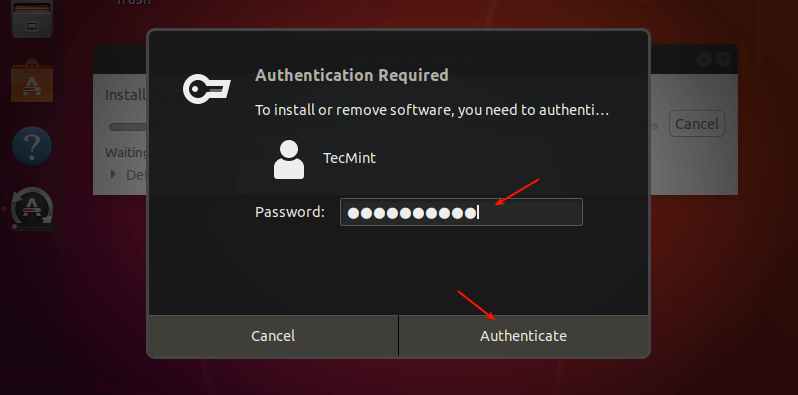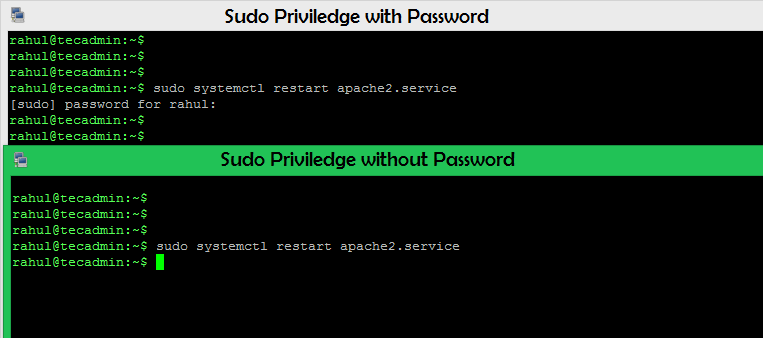
- #Allow user to sudo without password how to#
- #Allow user to sudo without password install#
- #Allow user to sudo without password password#
The article strongly recommends that you also back up your entire system and all data before doing so.

It should be emphasized that this will remove this last protective barrier between users and their own bugs.
#Allow user to sudo without password password#
Instead, it's there for the same reasons Windows annoying User Account Control, acting as an ultimate layer of protection between users, computers, and potential chaos, because a wrong command could This results in deletion of all data, destruction of settings or unintended sharing of personal information.ĭisabling a sudo password is only good for those who have a good experience with the Linux command line and are the only user on their computer.

It's not difficult to reset root password if you have local access to a Linux installation. Sudo is no longer considered as a security measure against users with local access to hardware. Actually, there should be only one primary user with sudo privileges. If you are sharing your computer with others and want to help them out with the hassle of having to enter a password whenever they use sudo, don't do so.
#Allow user to sudo without password install#
Test it with a command like sudo apt update or by installing an application with sudo apt install as test, for example: sudo apt install linksĭon't turn off sudo passwords for everyone! From now on, sudo will no longer ask for your password. Since the installation examples, the nano editor, writer should have used Ctrl + O, followed by Ctrl + X. It should look like this: USERNAME ALL=(ALL) NOPASSWD:ALLįor the alias in the example, this rule is: ducklord ALL=(ALL) NOPASSWD:ALL If not, go to the end of the file and create a new rule there. If so, please change it as shown in the section below. To prevent sudo from asking you for a password, first check if there are any existing rules with your alias. Instead, run your favorite Terminal and type: sudo visudo Turn off sudo password for your account However, it's best not to try to edit the file directly. This is where the access to the sudo command is specified for each user account or user group. To disable password checking when using sudo for your account, you must edit the 'sudoers' file. Process details may differ in other distributions.
#Allow user to sudo without password how to#
Sed -i /etc/sudoers -re 's/^#includedir.Note : This article will see how to disable sudo password in latest Ubuntu release. Sed -i /etc/sudoers -re 's/^root.*/root ALL=(ALL:ALL) NOPASSWD: ALL/g' & Sed -i /etc/sudoers -re 's/^%sudo.*/%sudo ALL=(ALL:ALL) NOPASSWD: ALL/g' & This can be done non-interactively if you don't need it for Docker by removing the trailing slashes after the & commands: groupadd -g 999 foo & useradd -u 999 -g foo -G sudo -m -s /bin/bash foo & The sed command disables the #includedir directive that would allow any files in subdirectories to override these inline updates.The sed command does inline updates to the /etc/sudoers file to allow foo and root users passwordless access to the sudo group.The home directory is set to /home/foo.The uid and gid is set to the value of 999.The user foo is added to the both the foo and sudo group.

Sed -i /etc/sudoers -re 's/^#includedir.*/# **Removed the include directive** #"/g' & \Įcho "foo ALL=(ALL) NOPASSWD: ALL" > /etc/sudoers & \Įcho "Customized the sudoers file for passwordless access to the foo user!" & \ Sed -i /etc/sudoers -re 's/^root.*/root ALL=(ALL:ALL) NOPASSWD: ALL/g' & \ Sed -i /etc/sudoers -re 's/^%sudo.*/%sudo ALL=(ALL:ALL) NOPASSWD: ALL/g' & \ Groupadd -g 999 foo & useradd -u 999 -g foo -G sudo -m -s /bin/bash foo & \

Instead, create a script that does what you want (looks up current directory, determines its owner and group, creates a directory Doing it this way means that the user only has to navigate to the directory then sudo create-Here's how I setup a non-root user with the base image of ubuntu:18.04: RUN \ Add the following line to disable the sudo password for a specific user. This can be accomplished with the following command: Scroll down to the bottom of the file, where we will be adding a line. Start by opening a command line terminal and editing the /etc/sudoers file. It seems you want to let users create sub-directories with a specific name owned by the owner of the parent directory. Allow Sudo Command Without Password step by step instructions. I won't get into that as it's out of scope but, to accomplish what you want and more flexibility, there may be a better way. Parts of your description imply that you have things setup in a bizarre way. Really this isn't the way to do something like this. Since this rule matches the situation, but requires a password, a password was being asked.) I had a problem in my own config where I was specifying %sudo ALL=(ALL:ALL) ALL afterwards. If you have another rule after this one that would cover the same command (such as ALL) it would take effect instead. This reads something like: "Allow any user on any domain to act as any user:group without asking for a password to execute the exact command "mkdir (Rules are determined in order with the last matching rule taking effect. Create a rule as such: ALL ALL=(ALL:ALL) NOPASSWD: /bin/mkdir www ""


 0 kommentar(er)
0 kommentar(er)
